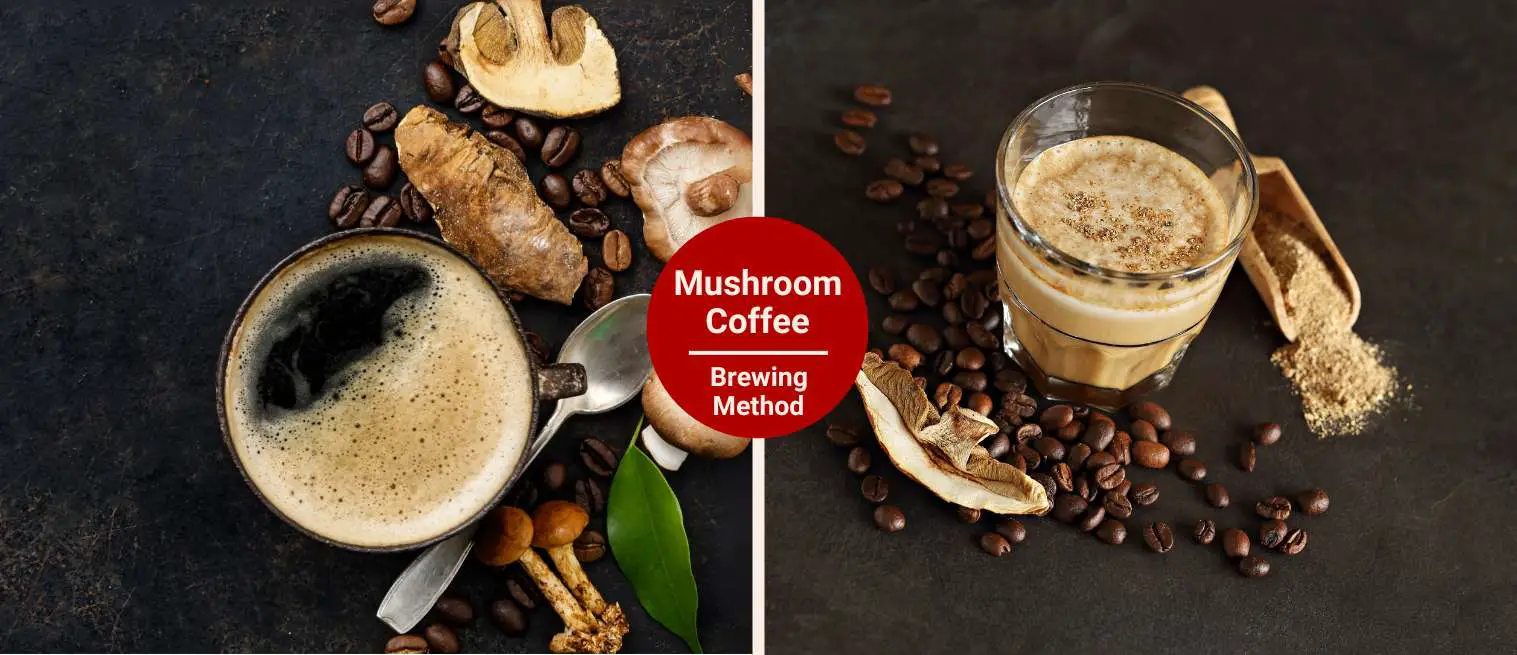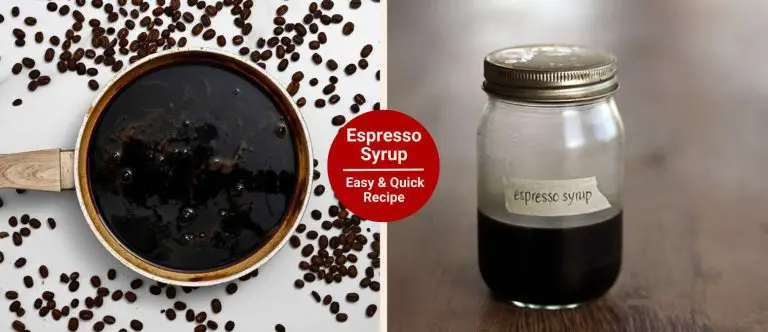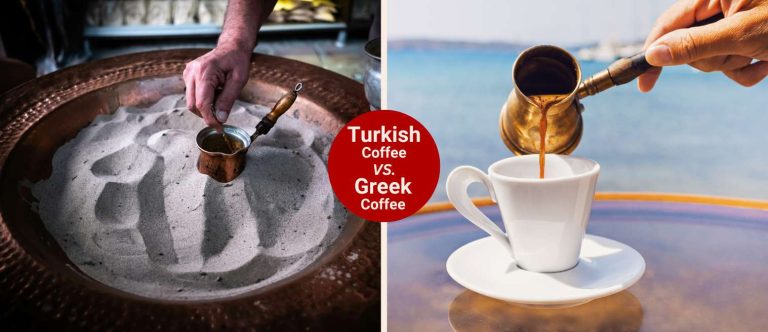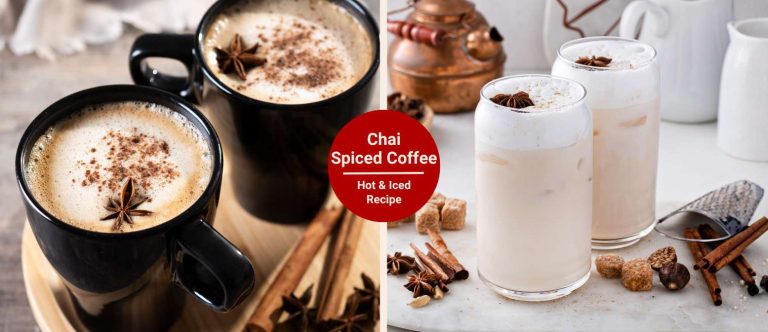How to Brew Mushroom Coffee (Easy Methods + Pro Tips)
Last updated on September 30th, 2025 at 12:15 pm
Have you ever wondered if there’s a right or wrong way to make mushroom coffee?
A few months ago, I shared my experience with mushroom coffee, and it wasn’t perfect at first. I thought it was as simple as scoop, pour and sip. Well, I was wrong!
The first few times I tried, the taste was either too earthy, too weak, or flat-out bitter. I was wasting good coffee and pricey mushroom powder.
After some trial and error (and a few mornings of scrunching up my face with a “what did I just drink” look), I started figuring it out.
For instance, adjusting water temperature, using a frother, or mixing the powders differently changed everything.
Suddenly, the cup was smoother, creamier, and actually enjoyable. That’s when I realized brewing mushroom coffee is simple, once you know a few tricks.
In this guide, you’ll learn how to brew mushroom coffee using different methods instant packets, ground blends, DIY powders, and even iced lattes. So, let’s start brewing!
What Is Mushroom Coffee (Quick Refresher)?
Mushroom coffee is a mix of regular ground coffee and functional mushrooms. For instance, lion’s mane, chaga, reishi, or cordyceps.
Usually, the mushrooms are dried and turned into powders or extracts, then blended with the coffee. As a result, you get a drink that’s often lower in caffeine than your standard cup. However, it’s loaded with bioactive compounds that can help with focus, calm energy, and overall wellness.
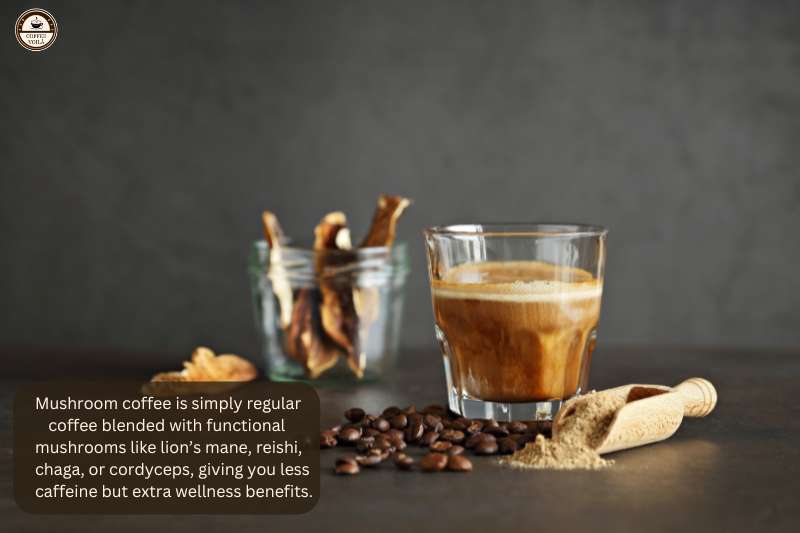
Before we talk about brewing methods, it’s helpful to understand how mushroom coffee works and why it’s gaining popularity.
I’ve already written a guide on mushroom coffee that covers the benefits, risks, and science behind it.
Anyway, it also comes in different forms:
- Instant mixes – Pre-portioned packets that dissolve in hot water within seconds. These are great for travel or busy mornings.
- Ground blends – Coffee grounds pre-mixed with mushroom powder. You can brew it like regular coffee in your French press, moka pot, or drip machine.
- DIY add-ins – Your standard coffee with a spoonful of mushroom powder (lion’s mane, reishi, etc.) stirred in. This method gives you the most control over flavor and dosage.
Notes: Each option has its pros and cons. But all three give you a similar balance: the familiar comfort of coffee with the earthy, adaptogenic kick of medicinal mushrooms.
Method 1) Brewing with Instant Mushroom Coffee Packets
If you want the absolute easiest way to make mushroom coffee, instant packets are the winner. I mean, you don’t need to grin, measure, or clean up. Just tear, pour, and stir. It really is that simple!
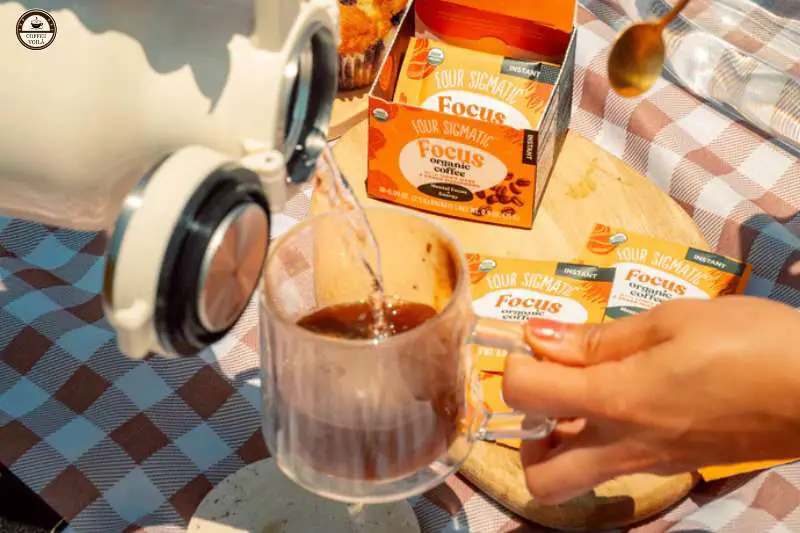
Why Choose Instant Packets?
- Fastest brewing method (literally under a minute)
- Perfect for busy mornings or on-the-go
- Pre-portioned. So no guesswork with scoops or ratios
Step-by-Step: How to Brew Instant Mushroom Coffee
- Grab one packet of mushroom coffee mix.
- Pour into your mug.
- Add 6–8 ounces of hot water (not boiling—195 to 205º F is best).
- Stir well until the powder dissolves.
- (Optional but recommended) Use a milk frother or blender for 15–20 seconds to create a smooth, café-style texture.
Brands Worth Trying
- Four Sigmatic: Focus-friendly blends with lion’s mane.
- Ryze: Balanced adaptogen blend with reishi, cordyceps, and more.
- MUD/WTR: Closer to a coffee alternative, with a rich, earthy flavor.
Pro Tip
If you’re brand-new to mushroom coffee, start with half a packet. This helps your stomach adjust to the mushroom compounds and stretches your stash a little longer.
Method 2 – Brewing Ground Mushroom Coffee
If you’re more of a “coffee ritual” type, ground mushroom coffee is probably your best bet. It feels familiar because you brew it the same way you would with regular coffee.
You still get to scoop, pour, and enjoy that rich coffee aroma filling the kitchen. The only thing is that alongside your usual brew, you’re also sipping on healthy mushroom compounds.
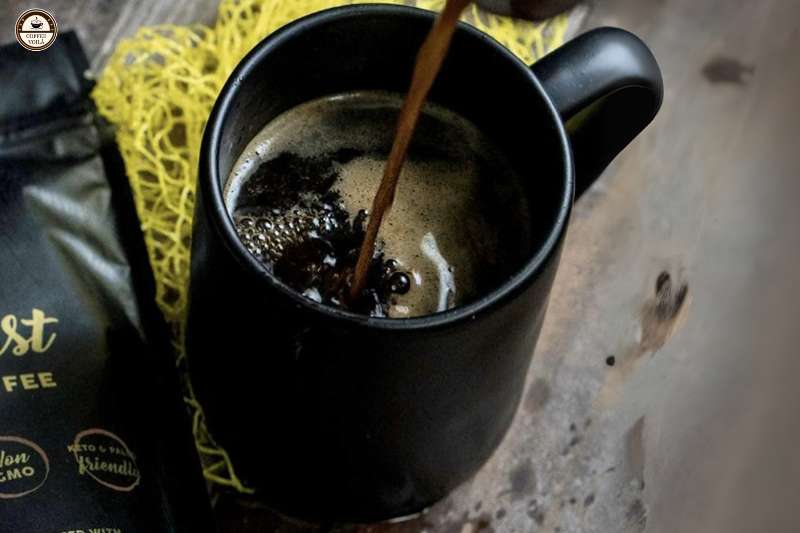
Why Choose Ground Mushroom Coffee?
- Works with the gear you already own (French press, drip machine, moka pot).
- You can control flavor and strength more than instant packets.
- Closer in taste to traditional coffee, but with a smoother, earthy undertone.
Step-by-Step: How to Brew Ground Mushroom Coffee
- Measure 1–2 tablespoons of ground mushroom coffee per 6–8 ounces of water.
- Add to your brewer of choice (French press, drip coffee maker, or moka pot all work well).
- Brew as usual, just like you would with standard coffee grounds.
- Adjust the grind size or ratio to fine-tune flavor and strength. The reason is that finer grinds give a stronger cup, while coarser grinds brew a lighter one.
- (Optional) Top with frothy milk or cream to balance the earthiness.
Brands Worth Trying
- Laird Superfood Mushroom Coffee: Smooth and balanced with added functional mushrooms.
- NeuRoast: Stronger in flavor, great if you like bold coffee with an adaptogenic twist.
Pro Tip
Ground mushroom coffee tends to brew a little earthier than your usual beans. For this reason, pair it with cinnamon or cacao to round out the flavor.
Method 3 – DIY Mushroom Coffee with Powders
This one’s for the control freaks. Instead of buying pre-mixed blends, you brew your regular coffee and then add mushroom powders yourself.
It’s the most flexible option because you decide which functional mushrooms to use, how much powder goes in, and what flavors to layer on top.
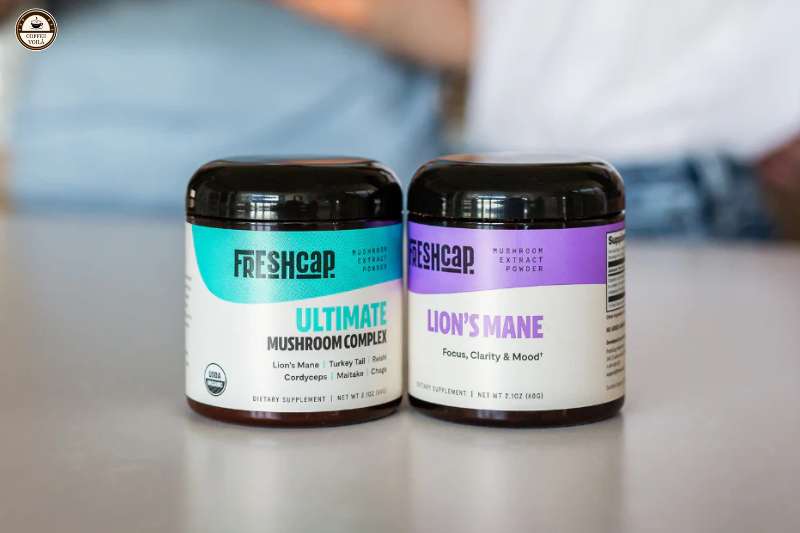
Why DIY?
The biggest reason is customization. For instance, maybe you want lion’s mane for focus on workdays, or reishi for winding down in the evening. With this option, you’re not locked into one company’s ratio. Rather, you’re in charge.
Step-by-Step: How to Do It
- Brew your favorite coffee: French press, pour-over, moka pot, whatever you love.
- Add mushroom powder: Start with ½ teaspoon and stir well. You can work up to 1 teaspoon once you know how your body handles it.
- Whisk or froth: A little handheld frother saves you from the dreaded “powder clumps.”
- Customize: Add honey, oat milk, or even adaptogens like ashwagandha if you’re into stacking.
Extra Tips
Go slow at first. Functional mushrooms like lion’s mane, cordyceps, and reishi pack bioactive compounds, and your gut might need time to adjust. Also, powders can taste earthy. Pairing with cacao or cinnamon makes the cup smoother (trust me, it’s a game-changer).
Example Brands
If you’re wondering where to start, powder from FreshCap is solid pick.
Notes: DIY mushroom coffee feels more “hands-on.” However, once you get your rhythm, it’s honestly the most rewarding way to brew. You end up with a cup that’s not simply coffee, but your own creation.
Method 4 – Iced or Blended Mushroom Coffee
Hot coffee is great! But sometimes you want something cold and refreshing, especially on a hot day or after a workout. That’s where iced or blended mushroom coffee comes in.
Basically, it’s the same brew you’d make with instant or ground mushroom coffee, but with a fun icy twist.

Why Go Iced or Blended?
Two reasons: temperature and texture. The reason is that cold mushroom coffee goes down smoother when you’re not in the mood for heat. And blending it with milk turns it into a creamy latte-style drink.
Plus, iced versions are easier on the stomach for some people, since the chill takes the edge off coffee’s acidity.
Step-by-Step: How to Do It
- Brew your base: Start with hot mushroom coffee (instant packets or ground brew both work).
- Cool it down: Pour over a glass filled with ice. Next, let it sit for a minute so it doesn’t instantly melt everything.
- Blend it (optional): Toss the brewed coffee, ice, and almond or oat milk into a blender. You may also add a touch of sweetener if you like.
- Flavor boost: Sprinkle in cacao, cinnamon, or a drop of vanilla extract. Afterward, blend until creamy.
Extra Tips
If you want that café-style froth, blending is the secret weapon. It transforms mushroom coffee into something that tastes like a coffee latte without the $6 price tag. Furthermore, don’t be shy with spices: cacao and cinnamon pair really well with the earthy mushroom notes.
Tips for the Best Mushroom Coffee Experience
If you’re going to drink mushroom coffee regularly, you might as well make it taste great and feel smooth. A few small tweaks can change the experience from “meh” to café-worthy. For instance:
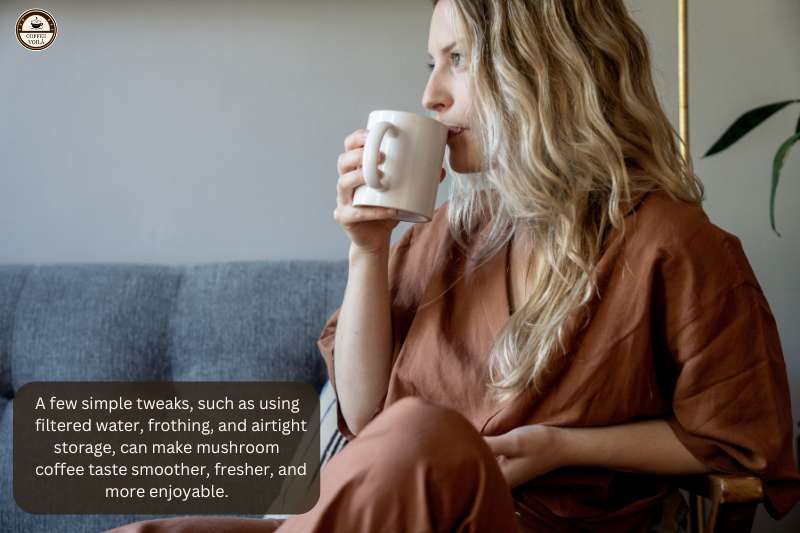
1 – Use Filtered Water for Cleaner Flavor
Typically, tap water can mess with the taste and aroma of your coffee, especially if it’s loaded with minerals or chlorine.
So, switch to filtered water and you’ll notice the earthy mushroom notes come through much cleaner, while the bitterness of the coffee softens.
2 – Froth or Blend to Reduce Powdery Texture
Mushroom powders don’t always dissolve perfectly. Also, stirring with a spoon leaves that gritty layer at the bottom of the cup.
I recommend a cheap handheld frother or tossing it in a blender for 10 seconds. This quickly makes the drink creamy and smooth and similar to a latte.
Bonus: blending brings out flavors when you add extras like cinnamon or cacao.
3 – Store Mushroom Coffee in an Airtight Container for Freshness
Mushroom coffee powders and blends are sensitive to air and moisture. If you leave the bag open, they lose flavor fast and can even clump.
I suggest keeping it in a glass jar with a tight lid (like a Mason jar or an airtight OXO container). Plus, freshness means you’re getting the antioxidants and bioactive compounds (not stale dust).
Common Brewing Mistakes to Avoid
I made a few mistakes at the beginning (more than once). Now that I’ve learned the hard way, here are a few slip-ups you’ll want to dodge.
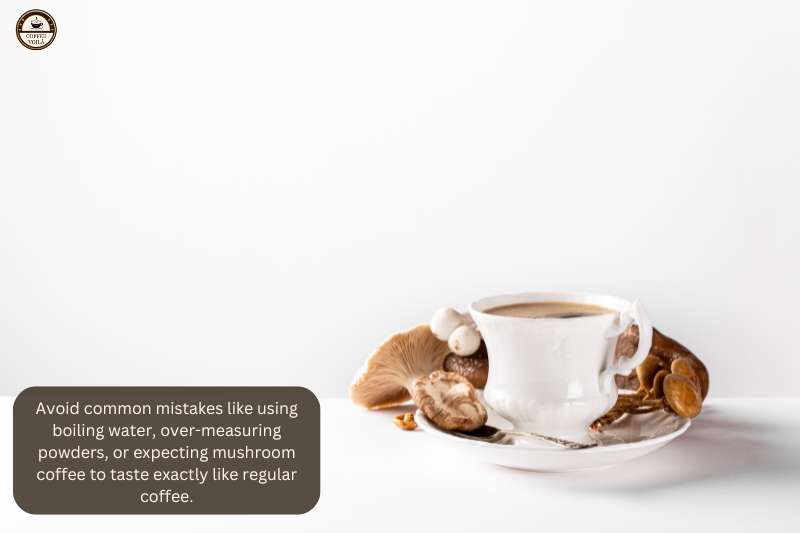
Using Boiling Water with Instant Mixes
I used to pour freshly boiled water straight into my instant mix. The problem is that boiling water can scorch the delicate mushroom compounds and coffee base, leaving a bitter aftertaste. Instead, let the water cool for about 30–60 seconds before pouring—it makes the earthy flavor much smoother.
Over-Measuring Powders
This one’s tempting. A heaping spoon of lion’s mane or reishi powder looks harmless, but too much will give you an overpowering, dirt-like taste. Start with just ½ teaspoon and adjust slowly. Remember, you can always add more, but you can’t undo a heavy-handed scoop.
Expecting Identical Taste to Regular Coffee
Mushroom coffee isn’t meant to taste like your usual bold espresso shot. It’s milder, earthier, and sometimes even a little nutty depending on the blend.
If you expect it to be a clone of regular coffee, you’ll probably be disappointed. Instead, appreciate it as its own thing—a functional drink with adaptogens and wellness benefits baked in.
Last Thoughts
I recommend starting simple: experiment with add-ins and build a mushroom coffee routine that makes mornings (or afternoons) feel like your best self.
Now I’m curious, have you tried any of the methods I shared? Do you have tricks you’ve learned along the way? Drop them in the comments, let’s stay connected and with that, voilà!

